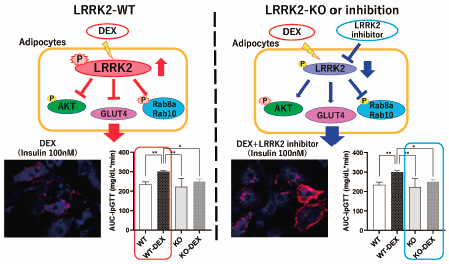- 著者
- Motoki Imai Fumitaka Kawakami Makoto Kubo Makoto Kanzaki Hiroko Maruyama Rei Kawashima Tatsunori Maekawa Yoshifumi Kurosaki Fumiaki Kojima Takafumi Ichikawa
- 出版者
- The Pharmaceutical Society of Japan
- 雑誌
- Biological and Pharmaceutical Bulletin (ISSN:09186158)
- 巻号頁・発行日
- vol.43, no.11, pp.1660-1668, 2020-11-01 (Released:2020-11-01)
- 参考文献数
- 44
- 被引用文献数
- 5
Mutations in the leucine-rich repeat kinase 2 (LRRK2) gene are associated with Parkinson’s disease. LRRK2 is a large protein with multiple functional domains, including a guanosine 5′-triphosphate (GTP)-binding domain and a protein kinase domain. Recent studies indicated that the members of the Rab GTPase family, Rab8a and Rab10, which are involved in the membrane transport of the glucose transporter type 4 (GLUT4) during insulin-dependent glucose uptake, are phosphorylated by LRRK2. However, the physiological role of LRRK2 in the regulation of glucose metabolism is largely unknown. In the present study, we investigated the role of LRRK2 using dexamethasone (DEX)-induced glucose intolerance in mice. LRRK2 knockout (KO) mice exhibited suppressed glucose intolerance, even after treatment with DEX. The phosphorylation of LRRK2, Rab8a and Rab10 was increased in the adipose tissues of DEX-treated wild-type mice. In addition, inhibition of the LRRK2 kinase activity prevented the DEX-induced inhibition of GLUT4 membrane translocation and glucose uptake in cultured 3T3-L1 adipocytes. These results suggest that LRRK2 plays an important role in glucose metabolism in adipose tissues.
- 著者
- Shigeru Ishida Ken Masuguchi Takehiro Kawashiri Toshikazu Tsuji Hiroyuki Watanabe Sayuri Akiyoshi Makoto Kubo Satohiro Masuda Nobuaki Egashira
- 出版者
- The Pharmaceutical Society of Japan
- 雑誌
- Biological and Pharmaceutical Bulletin (ISSN:09186158)
- 巻号頁・発行日
- vol.43, no.4, pp.663-668, 2020-04-01 (Released:2020-04-01)
- 参考文献数
- 38
- 被引用文献数
- 1 2
Hypersensitivity reactions, including anaphylaxis, are common side effects associated with docetaxel treatment in breast cancer patients. However, preventive measures have not yet been established. In this study, we retrospectively analyzed the risk factors for developing anaphylaxis in 182 female breast cancer patients treated with docetaxel. We found that 6.6% of all patients (n = 12) experienced anaphylaxis. Multivariate analyses indicated that concentration of docetaxel higher than 0.275 mg/m2/mL, docetaxel dose rate higher than 1.15 mg/m2/min, and white blood cell count less than 4290 cells/mL are risk factors for developing docetaxel-related anaphylaxis. In particular, concentrations of docetaxel or doses per administration time were associated with a high odds ratio (11.88 or 11.60) for docetaxel-related anaphylaxis. Moreover, patients receiving doses in 250 mL volume experienced anaphylaxis more frequently than those receiving doses in 500 mL (7.0 vs. 0.9%, p = 0.0236). Additionally, patients receiving treatments over 60 min tended to experience anaphylaxis more frequently than those who were treated over 90 min (6.7 vs. 1.1%, p = 0.0637). The present results indicate that high docetaxel concentrations, high dose rates, and low white blood cell counts are risk factors for developing docetaxel-related anaphylaxis, and administering docetaxel diluted in 500 mL over 90 min may limit docetaxel-induced hypersensitivity reactions.

